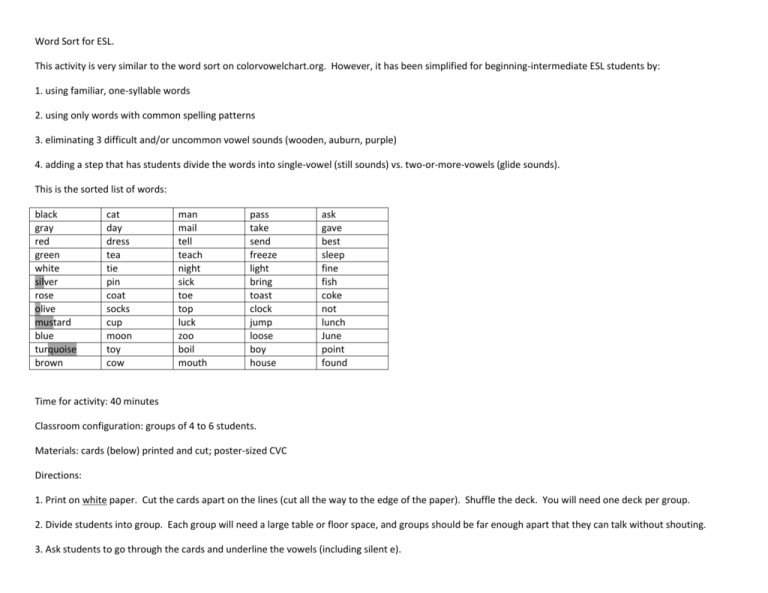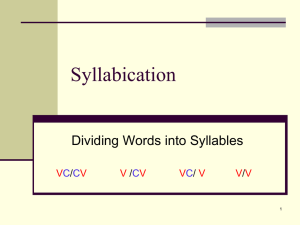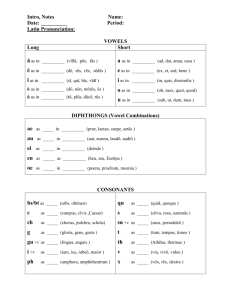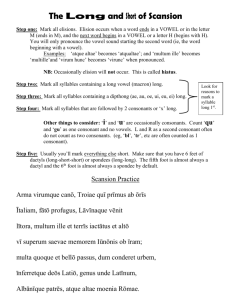sorting activity
advertisement

Word Sort for ESL. This activity is very similar to the word sort on colorvowelchart.org. However, it has been simplified for beginning-intermediate ESL students by: 1. using familiar, one-syllable words 2. using only words with common spelling patterns 3. eliminating 3 difficult and/or uncommon vowel sounds (wooden, auburn, purple) 4. adding a step that has students divide the words into single-vowel (still sounds) vs. two-or-more-vowels (glide sounds). This is the sorted list of words: black gray red green white silver rose olive mustard blue turquoise brown cat day dress tea tie pin coat socks cup moon toy cow man mail tell teach night sick toe top luck zoo boil mouth pass take send freeze light bring toast clock jump loose boy house ask gave best sleep fine fish coke not lunch June point found Time for activity: 40 minutes Classroom configuration: groups of 4 to 6 students. Materials: cards (below) printed and cut; poster-sized CVC Directions: 1. Print on white paper. Cut the cards apart on the lines (cut all the way to the edge of the paper). Shuffle the deck. You will need one deck per group. 2. Divide students into group. Each group will need a large table or floor space, and groups should be far enough apart that they can talk without shouting. 3. Ask students to go through the cards and underline the vowels (including silent e). 4. Tell students that syllables with 2 or more vowels are called GLIDE syllables, and syllables with one vowel are called STILL syllables. Use still and glide A as an example – demonstrate how the mouth changes shape (glides) during the glide A, but stays still during the still A. Because the mouth has to make 2 different shapes, glide syllables are usually spelled with 2 or more vowels. Say you will talk about this a lot more in the classes to come. For now, they should simply divide the cards into 2 stacks: still syllables and glide syllables. note: you may need to discuss the “silent e” as a second vowel. Point out that E has this special role, and no other vowel is usually silent at the end of a word. note: a few of the color words have 2 syllables. In that case, consider only the vowels in the highlighted syllable. note: the words “night” and “light” have only 1 vowel, but do NOT sound the same as the still vowel words. Point out that this is a common spelling pattern that applies only to glide I. 5. Ask students to take the still pile and divide it into 5 smaller piles depending on the sound that the vowel makes. Each pile should have 5 cards. 6. Likewise, students should divide the glide pile into 7 smaller piles of 5 cards. 7. Ask students to find the cards that name colors and put them on the top of each pile. Discuss: Which vowel sounds are usually spelled the same? -- Generally still vowels are spelled in one way, but students will probably realize there are many exceptions. Glide vowels tend to have 2 or more common spellings. Practice: you can practice pronunciation one pile at a time, emphasizing that the vowels in each pile should sound the same. Alternatively, read one pile to the students but add in one word from another pile, and ask them which word had a different vowel sound. Apply to color vowel chart: Tell students that they have just found the 12 most common vowel sounds in English. Lay a poster-sized version of the CVC on a table and let students place their piles (color word up) on the chart. black cat green tea gray day white tie red dress silver pin rose coat blue moon olive socks turquoise toy mustard cup brown cow man pass ask mail take gave tell send best teach freeze sleep night light fine sick bring fish toe toast coke top clock not luck jump lunch zoo loose June boil boy point mouth house found








